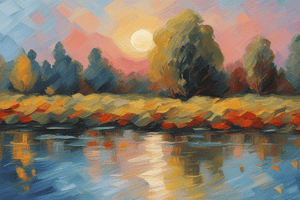Podcast
Questions and Answers
Which marker is primarily used for diagnosing myocardial necrosis that develops after CABG surgery?
Which marker is primarily used for diagnosing myocardial necrosis that develops after CABG surgery?
- IMA (correct)
- BNP
- hsCRP
- CK-MB
What is the primary source of BNP secretion in the body?
What is the primary source of BNP secretion in the body?
- Kidneys
- Atria
- Ventricles (correct)
- Brain
Which marker is considered more important than ANP in the context of heart failure?
Which marker is considered more important than ANP in the context of heart failure?
- BNP (correct)
- hsCRP
- CNP
- PAPP-A
Which of the following is indicated as a marker of inflammation and future morbidity and mortality risk?
Which of the following is indicated as a marker of inflammation and future morbidity and mortality risk?
Which natriuretic peptide is primarily released in response to atrial wall stretching?
Which natriuretic peptide is primarily released in response to atrial wall stretching?
What CRP level is classified as high risk for cardiovascular disease?
What CRP level is classified as high risk for cardiovascular disease?
Which cardiac marker is most specific for myocardial infarction?
Which cardiac marker is most specific for myocardial infarction?
Which condition is not associated with troponin elevation?
Which condition is not associated with troponin elevation?
What does CK-MB primarily indicate?
What does CK-MB primarily indicate?
Which of the following describes the relationship between CK-MB and total CK activity?
Which of the following describes the relationship between CK-MB and total CK activity?
What is the significance of elevated CRP levels?
What is the significance of elevated CRP levels?
In which condition would you expect to see a rise in CK-BB?
In which condition would you expect to see a rise in CK-BB?
A patient with severe traumatic injury could have an elevation in which biomarker?
A patient with severe traumatic injury could have an elevation in which biomarker?
Flashcards
hsCRP
hsCRP
Marker of inflammation, showing cardiovascular risk and future morbidity/mortality.
Marker of Myocardial Ischemia
Marker of Myocardial Ischemia
IMA, used to diagnose myocardial necrosis after CABG.
natriuretic peptides
natriuretic peptides
Marker of hemodynamic stress, released in response to heart stretching and volume.
BNP
BNP
Signup and view all the flashcards
cTn
cTn
Signup and view all the flashcards
CRP Elevation
CRP Elevation
Signup and view all the flashcards
hsCRP Levels and Risk
hsCRP Levels and Risk
Signup and view all the flashcards
Troponin
Troponin
Signup and view all the flashcards
Cardiac Biomarkers
Cardiac Biomarkers
Signup and view all the flashcards
CK-MB
CK-MB
Signup and view all the flashcards
Early MI Detection
Early MI Detection
Signup and view all the flashcards
Conditions Elevating Troponin
Conditions Elevating Troponin
Signup and view all the flashcards
Creatine Kinase (CK) Isoenzymes
Creatine Kinase (CK) Isoenzymes
Signup and view all the flashcards
Study Notes
Cardiac Biomarkers
- Markers of Inflammation: hsCRP, SCD40L, homocysteine, PAPP-A, LP-PLA2
- Markers of Plaque Destabilization: hsCRP, PAPP-A, SCD40L, LP-PLA2, homocysteine
- Markers of Myocardial Ischemia: IMA (used for diagnosing myocardial necrosis after CABG, normal levels 1.6-19ng/ml)
- Markers of Cardiac Necrosis: cTn, CK-MB, Myoglobin
- Marker for Hemodynamic Stress: Natriuretic peptides (ANP released in response to atrial wall stretching, BNP primarily from ventricles)
- BNP: More important than ANP in heart failure, higher levels in patients with cardiovascular or renal disease, found in brain and vascular endothelial cells.
- hsCRP Clinical Uses: Screening for cardiovascular risk, predicting disease severity in pre-existing coronary artery disease, predicts long-term risk of first MI and ischemic stroke. Low risk <1.0 mg/L, Intermediate risk 1.0-2.9 mg/L, High risk >3.0 mg/L
- Troponin: Most diagnostic for MI, cTn is specific for heart, cTnI is the most specific for the heart.
- Creatine Kinase (CK): CK-BB (brain origin), CK-MB (myocardial origin, specific for heart), CK-MM (skeletal muscle origin). Ratio of CK-MB to total CK can suggest myocardial necrosis.
- Cardiac Enzymes: Myoglobin (onset 2-6hrs, peak 4-6hrs, return 24-36hrs), CK-MB (onset 4-6hrs, peak 18-30hrs, return 3-4 days), LDH (onset 24-48hrs, peak 14-21hrs, return 3-6 days).
- Troponin I: Earliest cardiac marker detected (3-5 hrs post-event)
- Gold Standard of cardiac biomarkers : Troponin
- CK Isoenzymes in Cardiac Muscle: MM, BB, and MB
- Conditions associated with troponin elevation: Arrhythmias, hypertension, congestive heart failure, myocarditis, coronary artery disease, pericarditis, coronary vasospasm, critically ill patients.
Case Example
- A 50-year-old male with chest pain and vomiting: indicates high likelihood of myocardial infarction, with troponin I being the first detectable cardiac marker
- Patient with chest pain after MI: troponin I would be the best cardiac marker to investigate chest pain.
Studying That Suits You
Use AI to generate personalized quizzes and flashcards to suit your learning preferences.




